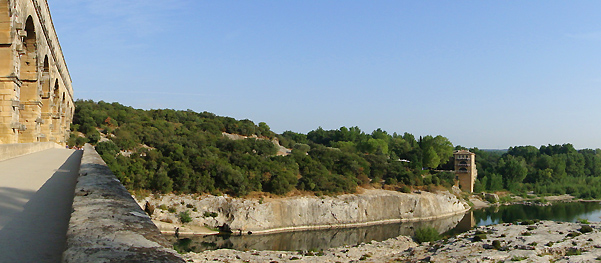Length of the canal : 50 km
Gradient : 12.40 m
Length of the aqueduct : 360m
Height of the aqueduct : 48.77 m
The history of the Pont du Gard
Nîmes, colonised by the Romans, expanded rapidly, with a population close to 20,000 inhabitants. It soon became apparent that the local Nemausus spring was not sufficient to supply enough water for the town's numerous projects (baths, fountains, drainage systems…)
The Roman authorities therefore decided to draw upon the strong Eure spring, from the Uzège region, and they began, during the course of the 1st century BC, to devise and build a canal of some fifty kilometres long to carry the water to the Nîmes delivery tank.
Whilst the whole of the project is built on a huge scale, one of its most impressive aspects is the canal's gradient – 12.30m over 50 km, which represents 25 cm/kilometre, an extraordinary feat, even by today’s standards…
It would take the water approximately an entire day to reach, through gravity, the city of Nîmes, and the canal carried, during its heyday, about 40,000m3 per day.
The most prestigious section of the canal remains the aqueduct of the Pont du Gard which straddles the river Gardon on the commune of Vers-Pont-du-Gard. The monument, which features on the UNESCO List of World Heritage Sites, took a workforce of around one thousand men four to five years to complete.
The aqueduct, entirely made with the region's stones, counted 54 arches built over three levels. 21,000 m3 of stones were assembled (some 50,400 tonnes), and most of the construction was made without mortar. Numerous inscriptions and engravings can still be seen on the stones, providing an insight into how accurately and precisely the work was carried out. A great many leverage point have also been identified, enabling historians to work out the methods used to erect the bridge (scaffolds, hoisting devices…).
Of the quarries which were used at the time, a number remain active to this day, amongst which La Pierre du Pont du Gard which is amongst the most efficient, thanks to a dynamic team with huge levels of experience.
Find out more: www.PierreduPontduGard.com
|
Visiting the Pont du Gard
Left untendered for a long time - the canal was even used at times as a makeshift quarry - the site and its environs are now listed and protected. There are a number of different ways in which visitors can find out more about this unique venue.
The museum, based around the theme of water, depicts, through videos and models a number of various themes. You can find out all about the Gallo-Roma civilisation and its various sites, view the different stages required for the construction of an aqueduct and also see a number of different representations of the Pont du Gard through the ages.
The open air exhibition entitled 'Mémoires de garrigues' sets out, over a 90 minute-long circuit, the area's nature as it has evolved over the past twenty centuries.
Ludo is an area dedicated to children from 5 to 12 years old. Participants become actors of one of the four themes on offer: Traces of the Past, Nature observation, Water, the Past.
A cinema, a multi-media library and commented visits are also available.
Numerous events are organised over the summer months: dances, balls, concerts, shows, traditional dance evenings… |



